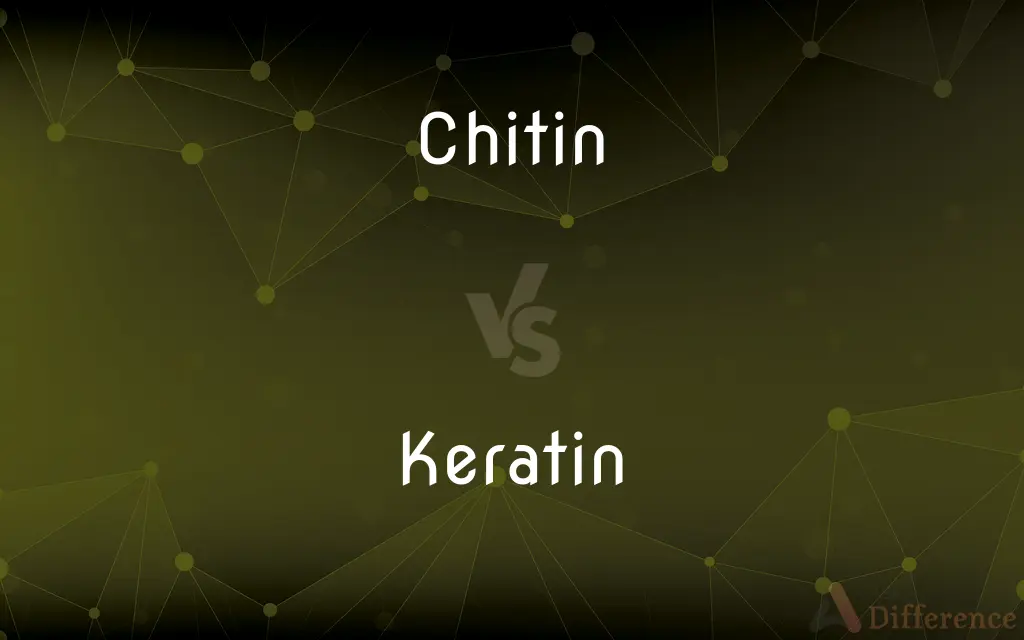Chitin vs. Keratin — What's the Difference?
Edited by Tayyaba Rehman — By Fiza Rafique — Updated on May 2, 2024
Chitin is a long-chain polymer found in exoskeletons of arthropods and fungi cell walls, notable for its role in structural support, while keratin is a protein found in vertebrates' hair, nails, and skin, crucial for protection and structural integrity.

Difference Between Chitin and Keratin
Table of Contents
ADVERTISEMENT
Key Differences
Chitin, composed of N-acetylglucosamine, is a major component in the exoskeletons of insects, crustaceans, and other arthropods, providing structural support and protection. Conversely, keratin, made up of various amino acids, forms the primary structural element of hair, nails, and the outer layer of skin in vertebrates.
The function of chitin includes providing rigidity and strength to the exoskeletons, which is essential for the protection and mobility of arthropods. On the other hand, keratin provides hardness and water resistance, protecting vertebrates from environmental damage such as water loss, wear, and tear.
Chitin is biodegradable and plays an important ecological role in the decomposition process in nature, often being recycled by organisms that can digest it. In contrast, keratin is quite resistant to digestion and degradation, which is why hair and nails are durable and persistent in the environment.
From an application perspective, chitin is used in medical and industrial fields, particularly for its biodegradable properties in wound dressings and as a biopolymer base for various materials. Keratin, however, is utilized in the cosmetic industry, especially in products designed to strengthen hair and nails.
Chitin is often extracted from shellfish waste, making it a valuable resource for creating sustainable materials. Keratin, frequently derived from animal hair or feathers, is used in textiles and as a supplement for hair and nail growth.
ADVERTISEMENT
Comparison Chart
Composition
N-acetylglucosamine, a sugar derivative
Amino acids, forming fibrous proteins
Found In
Exoskeletons of arthropods, cell walls of fungi
Hair, nails, and skin of vertebrates
Function
Structural support, protection
Protection, structural integrity, water resistance
Degradability
Biodegradable, recycled in nature
Resistant to degradation, durable
Applications
Medical fields, biopolymers, agriculture
Cosmetics, textiles, health supplements
Compare with Definitions
Chitin
Plays a protective role in the animal kingdom.
Chitin provides durability and protection to insects like ants and beetles.
Keratin
Provides rigidity and protection to epidermal tissues.
Keratin in the skin helps prevent water loss and protects against abrasion.
Chitin
A structural polysaccharide forming part of the exoskeleton in arthropods.
The chitin in a beetle's shell helps it resist physical damage.
Keratin
A fibrous protein that forms the structural component of hair and nails.
Keratin treatments are used to strengthen and smooth hair.
Chitin
Extracted from crustacean shells for various uses.
Chitin extracted from crab shells is used in creating wound dressings.
Keratin
Durable and resistant to enzymatic breakdown.
Nails are composed of hard keratin, which is tough and slow to degrade.
Chitin
Found in fungal cell walls, contributing to their rigidity.
The chitin in mushroom cell walls gives them their firm texture.
Keratin
Used in cosmetics for its strengthening properties.
Many shampoos contain keratin to help fortify hair strands.
Chitin
Biodegradable and used in ecological applications.
Chitin-based materials are prominent in biodegradable packaging solutions.
Keratin
Found in various vertebrate tissues, including the outer layers of skin.
The keratin layer of the skin acts as the first barrier against environmental elements.
Chitin
Chitin (C8H13O5N)n ( KY-tin) is a long-chain polymer of N-acetylglucosamine, an amide derivative of glucose. This polysaccharide is a primary component of cell walls in fungi, the exoskeletons of arthropods, such as crustaceans and insects, the radulae of molluscs, cephalopod beaks, and the scales of fish and skin of lissamphibians, making it the second most abundant polysaccharide in nature, behind only cellulose.
Keratin
Keratin () is one of a family of fibrous structural proteins known as scleroproteins. α-Keratin is a type of keratin found in vertebrates.
Chitin
A fibrous substance consisting of polysaccharides, which is the major constituent in the exoskeleton of arthropods and the cell walls of fungi.
Keratin
A fibrous protein forming the main structural constituent of hair, feathers, hoofs, claws, horns, etc.
Chitin
A nitrogen-containing polysaccharide that is a tough, protective, semitransparent substance and is the principal component of arthropod exoskeletons and the cell walls of certain fungi.
Keratin
Any of a class of filamentous proteins that are abundant in the cytoskeleton of vertebrate epithelial cells and are the main constituents of the outer layer of skin and tough epidermal structures such as hair, nails, hooves, feathers, and claws.
Chitin
(carbohydrate) A complex polysaccharide, a polymer of N-acetylglucosamine, found in the exoskeletons of arthropods and in the cell walls of fungi; thought to be responsible for some forms of asthma in humans.
Keratin
Material composed principally of keratin proteins.
Chitin
A white amorphous horny substance forming the harder part of the outer integument of insects, crustacea, and various other invertebrates; entomolin.
Keratin
(protein) The protein of which hair and nails are composed.
Chitin
A tough semitransparent horny substance; the principal component of the exoskeletons of arthropods and the cell walls of certain fungi
Keratin
A sulfur-containing fibrous protein constituting the main structural protein of hard epidermal tissues, such as horn, hair, feathers, nails, claws, hoofs, and the like. It is an insoluble substance, and, unlike elastin, is not dissolved even by gastric or pancreatic juice. By decomposition with sulphuric acid it yields leucine and tyrosine plus various other acid-stable amino acids. The amino acid composition varies, but it usually has a high percentage of cystine, which stabilizes and insolubilizes the protein by forming intrachain linkages. A softer form of keratin is present in the epidermis and whalebone. Called also epidermose.
Keratin
A fibrous scleroprotein that occurs in the outer layer of the skin and in horny tissues such as hair feathers nails and hooves
Common Curiosities
Can keratin be digested by humans?
Keratin is generally resistant to digestion by humans, contributing to its durability in hair and nails.
What are the primary uses of keratin?
Keratin is widely used in the cosmetic industry to strengthen hair and nails and is also found in textiles and health supplements.
How does the biodegradability of chitin impact its uses?
Chitin's biodegradability makes it suitable for medical applications and environmentally friendly materials.
What role does keratin play in vertebrate animals?
Keratin provides structural integrity, protection, and water resistance to hair, nails, and skin.
Where is chitin typically found?
Chitin is found in the exoskeletons of arthropods and the cell walls of fungi.
Are there medical applications for both chitin and keratin?
Chitin is used in wound healing and medical bandages, while keratin's applications lean more towards cosmetic enhancements.
What are the main differences in composition between chitin and keratin?
Chitin is a polymer made from N-acetylglucosamine, whereas keratin is composed of amino acids.
How are chitin and keratin extracted for commercial use?
Chitin is primarily extracted from shellfish waste, while keratin is often derived from animal hair, feathers, or wool.
What ecological roles do chitin and keratin play?
Chitin plays a role in the natural decomposition process, whereas keratin, due to its durability, can persist in the environment.
What makes chitin and keratin essential in nature?
Both substances provide crucial structural and protective functions to various organisms, with chitin supporting arthropods and fungi, and keratin providing resilience and protection in vertebrates.
Share Your Discovery

Previous Comparison
Decklid vs. Liftgate
Next Comparison
Commission vs. SalaryAuthor Spotlight
Written by
Fiza RafiqueFiza Rafique is a skilled content writer at AskDifference.com, where she meticulously refines and enhances written pieces. Drawing from her vast editorial expertise, Fiza ensures clarity, accuracy, and precision in every article. Passionate about language, she continually seeks to elevate the quality of content for readers worldwide.
Edited by
Tayyaba RehmanTayyaba Rehman is a distinguished writer, currently serving as a primary contributor to askdifference.com. As a researcher in semantics and etymology, Tayyaba's passion for the complexity of languages and their distinctions has found a perfect home on the platform. Tayyaba delves into the intricacies of language, distinguishing between commonly confused words and phrases, thereby providing clarity for readers worldwide.
















































